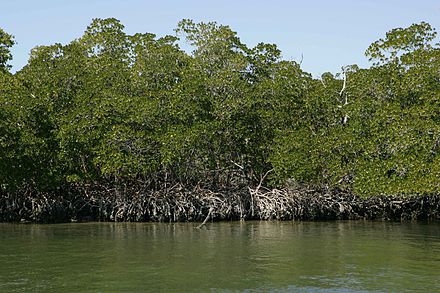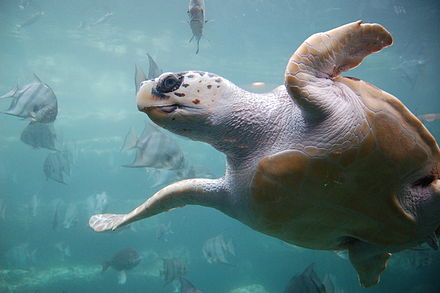Ten Thousand Islands National Wildlife Refuge
| Ten Thousand Islands National Wildlife Refuge | |
|---|---|
 Refuge in 2014 | |
| Nearest city | Goodland, Florida |
| Coordinates | 25°55′25″N 81°33′50″W / 25.9236°N 81.564°W / 25.9236; -81.564 |
| Area | 35,000 acres (140,000,000 m2) |
| Established | 1996 |
| Governing body | US Fish & Wildlife Service |
| Website | Ten Thousand Islands National Wildlife Refuge |
The Ten Thousand Islands National Wildlife Refuge is located in Southwest Florida in Collier County, between Marco Island and Everglades City, Florida. The refuge was first established in 1996 and covers 35,000 acres of the Ten Thousand Islands. The refuge includes both fresh and saltwater, and protects a large area of mangrove forest.
Activities include fishing, hunting, bird watching, kayaking and camping.
The refuge is home to a wide variety of plants and animals. There are approximately 200 species of fish, 189 species of birds and innumerable plant species.[1]
| Mangroves | |
|
|
Rhizophora mangle
The red mangrove is the most dominant species of mangrove in Florida and can be found as a shrub or as tall trees. They produce many viviparous seedlings that fall from the mangrove. |
|
|
Avicennia germinans
Black mangroves are very similar to the red mangroves in which they like to live in the most salt-rich soils. Pneumatophores extend from the soil and act as a root support system. |
|
|
Laguncularia racemosa
Unlike the red and black mangroves, the white mangrove usually grows on high, dryer land. The leaves of the white mangrove are different than the others because of its thick roundish leaves.[2] |
| Grasses | |
|---|---|
|
|
Spartina alterniflora
Mostly found in marsh-like areas and is quite invasive. Too much of this type of grass tends to reduce the mud feeding habitats of the local shorebirds.[3] |
|
|
Uniola paniculata
Usually found on sand dunes and very tolerant of salt spray, unlike most plants. |
| Exotic plants | |
|---|---|
|
|
Schinus terebinthifolius
Brazilian pepper, Florida holly, Christmas-berry or false pepper Reaches 12 meters high with intertwined branches. First introduced in the United States in 1898 by a plant explorer. The Brazilian pepper tree has taken over thousands of acres in south Florida and is rapidly growing.[4] |
|
|
Melaleuca quinuenervia
Melaleuca tree The melaleuca tree is becoming one of the most dominant invasive trees in south Florida. The reason they are so dangerous to South Florida is because they dry up areas that are supposed to be wet for most of the year.[5] |
| Shore birds | |
|---|---|
|
|
Sternula antillarum
Is the smallest of the American terns and is found nesting on sandy shores of the southern parts of the United States. Small fish are the main staple in their diet.[6] |
|
|
Rynchops niger
They get their name by skimming the lower part of their beak in the water to catch small fish. They are commonly found in dense colonies on sandy beaches. |
| Mammals | |
|---|---|
|
|
Procyon lotor
Raccoons are the main cause of loggerhead sea turtle nest depletion. Once these raccoons are removed from the smaller islands, the turtle nests tend to return.[7] |
|
|
Lontra canadensis
River otters can mostly be found in rivers, marshes and swamps. They eat fish, amphibians, turtles and crayfish.[8] |
|
|
Tursiops truncatus
The bottlenose dolphin is the most common type of dolphin. They can be found from pelagic to coastal waters.[9] |
| Reptiles | |
|---|---|
|
|
Anolis sagrei
The brown anole is very invasive and reaches exceptionally high population densities. The brown anole seems to be taking over the green anole's habitats. The brown anoles have even been known to eat green anoles. |
|
|
Anolis carolinensis
Green anoles feed on a variety of spiders, insects and other invertebrate. They can mostly be found living in trees. |
| Fishes | |
|---|---|
|
|
Megalops atlanticus
Tarpon are usually found in coastal bays, estuaries and mangrove lined lagoons. They feed on a wide variety or animals: from mullet and sardines to crabs. |
|
|
Centropomus undecimalis
Snook can be found inshore, around mangroves, bridges and seawalls. All snook are born males but when they become 18-22 inches in length some turn into females. |
|
|
Sciaenops ocellatus
Red drum, redfish Red drum is named after the drumming sound they make during spawning. As juveniles, redfish stay in rivers and bay areas but as they grow older they start to move towards coastal areas and open water. |
|
|
Cynoscion nebulosus
Spotted sea trout Spotted sea trout can be found around seagrass beds or oyster bars. Their main diet includes shrimp, pinfish or pigfish. |
| Threatened and endangered animals | |
|---|---|
|
|
Trichechus manatus
The West Indian manatee has been considered endangered since 1967. Manatees migrate seasonally with the changing temperatures. They can be found in fresh, brackish or salt water.[10] |
|
|
Haliaeetus leucocephalus
The bald eagle has been the national emblem of the United States since 1782. They mostly feed on fish and other birds and can be found anywhere from rivers, lakes, marshes and coastal areas. |
|
|
Caretta caretta
Atlantic loggerhead sea turtle The Atlantic loggerhead sea turtle is considered threatened. The population today is considered a fraction of what it used to be.[11] |
References
- ^ Sexton, N. R., Dietsch, A. M., Don Carlos, A. W., Koontz, L., Solomon, A. N., Miller, H. M. 2010-2011. Ten Thousand Islands National Wildlife Refuge. 5
- ^ Lin, G. H., Sternberd. 1992. Effect of Growth Form, Salinity, Nutrient and Sulfide on Photosynthesis, Carbon Isotope Discrimination and Growth of Red Mangrove (Rhizophora mangle L). 19(5):509-517
- ^ Daehler, C. C., Strong, D. R. 1996. Status, prediction and prevention of introduced cordgrass Spartina spp. invasions in Pacific estuaries, USA. 78:51-58
- ^ Langeland, K. A., Cherry, H. M., McCormick, C.M., Craddock, K.A. 2008. Identification & Biology of Non-Native Plants in Florida's Natural Areas-Second Edition.
- ^ Laroche, F. B., Ferriter, A. P. The Rate of Expansion of Melaleuca in South Florida. 1992. 30:62-65
- ^ Atwood, J. L., Kelly, P. R. 1984. Fish Dropped on Breeding Colonies as Indicators of Least Tern Food Habits. 96(1):34-47
- ^ Garmestani, A. S., Percival, H. F. Raccoon Removal Reduces Sea Turtle Nest Depredation in the Ten Thousand Islands of Florida.
- ^ Humphrey, S. R. 1982. Seasonal Habitat Use by River Otters and Everglades Mink in Florida. 46(2):375-381
- ^ Connor, R. C., Wells, R. S., Mann, J., Read, A. J. 2000. Cetacean Societies. 91-126
- ^ FWC. 2014. West Indian Manatee. 4:25-78
- ^ Davenport, M. 2014. Atlantic Loggerhead Turtle.
External links
- Official website








.jpg/440px-Black_Skimmer_(5005683576).jpg)
_2.jpg/440px-Raccoon_(Procyon_lotor)_2.jpg)
.jpg/440px-River_Otter_(7743626920).jpg)


.jpg/440px-Green_Anole_(20396330).jpg)

.jpg/440px-Snook_(159046493).jpg)




